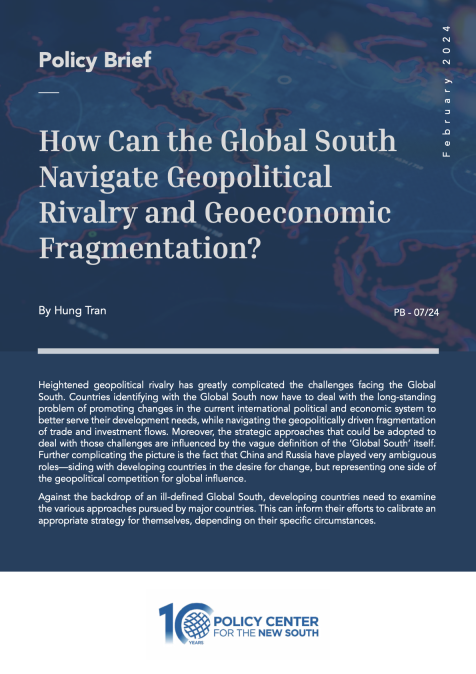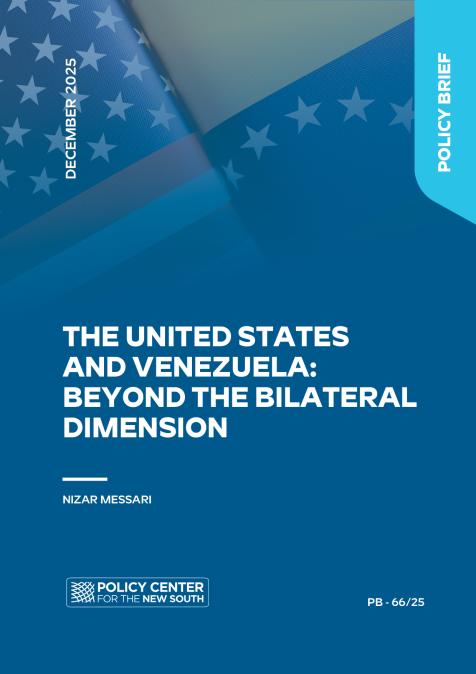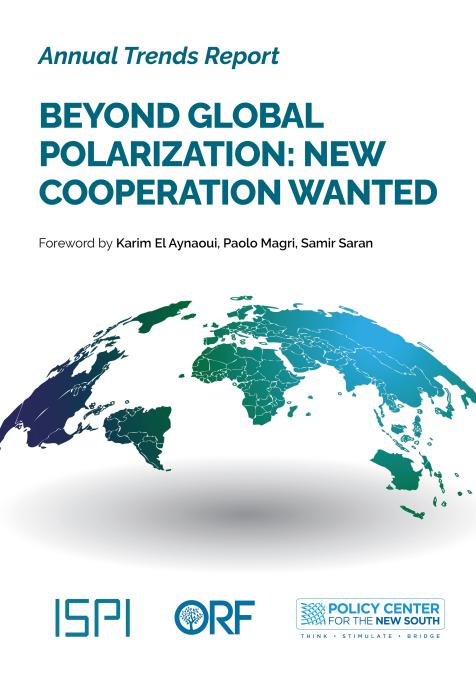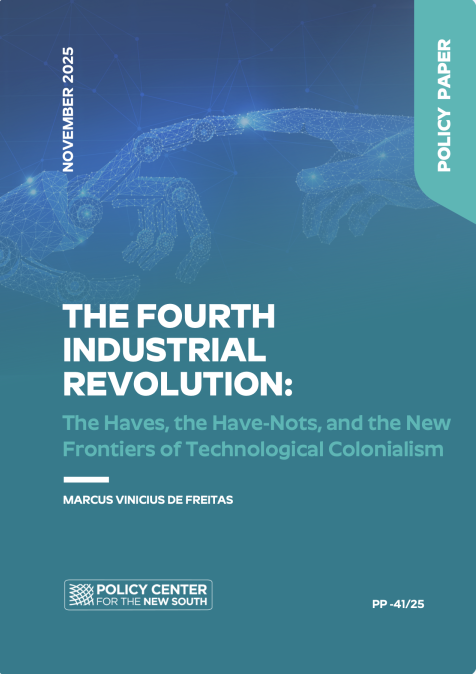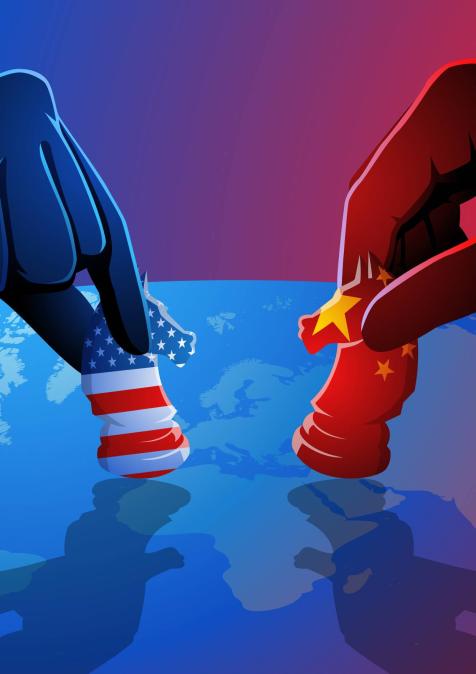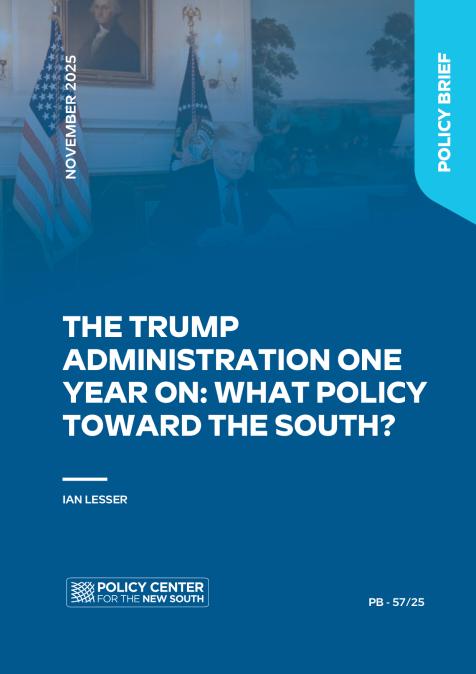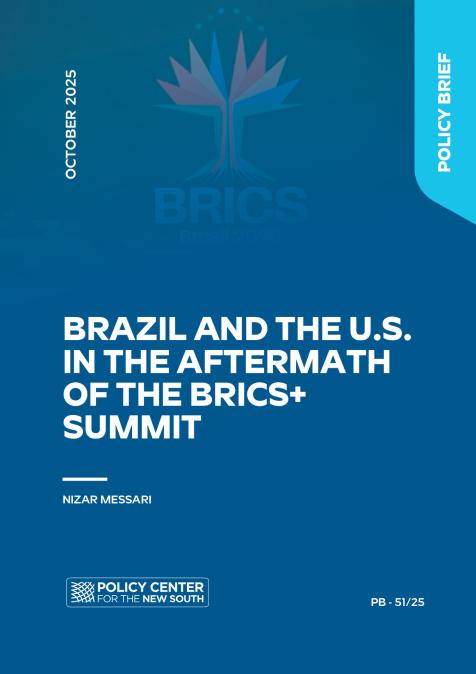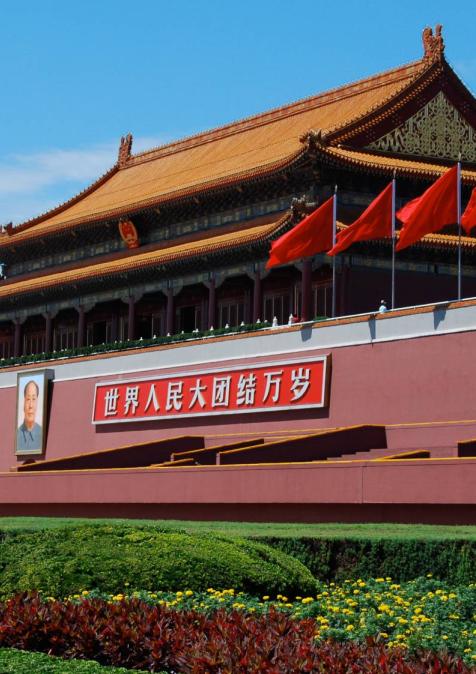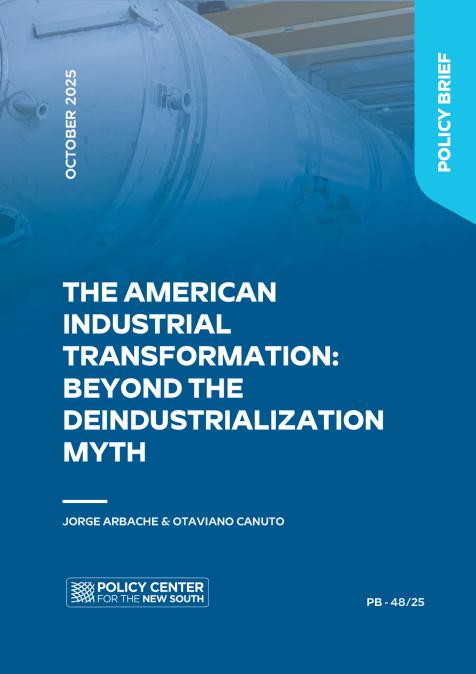Publications /
Policy Brief
Heightened geopolitical rivalry has greatly complicated the challenges facing the Global South. Countries identifying with the Global South now have to deal with the long-standing problem of promoting changes in the current international political and economic system to better serve their development needs, while navigating the geopolitically driven fragmentation of trade and investment flows. Moreover, the strategic approaches that could be adopted to deal with those challenges are influenced by the vague definition of the ‘Global South’ itself. Further complicating the picture is the fact that China and Russia have played very ambiguous roles—siding with developing countries in the desire for change, but representing one side of the geopolitical competition for global influence.
Against the backdrop of an ill-defined Global South, developing countries need to examine the various approaches pursued by major countries. This can inform their efforts to calibrate an appropriate strategy for themselves, depending on their specific circumstances.
HOW TO DEFINE THE ‘GLOBAL SOUTH’
The term ‘Global South’ conveys the notion of developing countries, many former colonies of Western powers. They share a general discontent with, and the desire to change, the current global political and economic order and its institutions—largely underpinned by the U.S. and its close allies in Europe and Asia, and seen as failing to meet the Global South’s development needs.
UNCTAD’s definitions of developing and developed countries have given some analysts a convenient way to conflate the Global South with developing countries. They prefer the term ‘Global South’ because it appears less judgmental or condescending than the terms developing or third-world countries. According to UNCTAD, developing countries consist of those in Africa, Latin America, the Caribbean, Asia with the exceptions of Japan, South Korea, and Israel, and Oceania without Australia and New Zealand. By comparison, developed countries are those in Europe, North America, and the countries in Asia and Oceania not defined as ‘developing’, as specified above.
Generally speaking, the term ‘Global South’, and its conflation with developing countries, have prompted criticism by many Western analysts. They point out that the term itself is geographically inaccurate as member countries are situated both in the Southern and Northern hemispheres. Furthermore, the Global South groups together many heterogeneous countries with different levels of development, political orientations, and views about the future international order. Consequently, such a diverse grouping cannot be cohesive enough to be a political force able to develop a common agenda to achieve agreed goals. While these observations are not without merits, it is a serious mistake for policymakers in developed countries to underestimate the rallying potential of the discontent with the current international order and the desire for change among developing countries—no matter how heterogeneous they are. In fact, this deeply felt sentiment, though not yet well articulated, has already shaped international relations—as demonstrated by the diminishing influences of the West in world affairs.
Moreover, how China and Russia play their hands and how these two countries are viewed by other developing countries will have a major influence over how the Global South evolves and how the West responds to it.
THE CASE OF RUSSIA
Having been sanctioned and isolated by the West after it invaded Ukraine, Russia has tried to make friends in the Global South, claiming to be part of the group. President Vladimir Putin has declared that Russia is a natural leader of the anti-colonial movement among developing countries, with the aim of ending U.S. hegemony. Putin’s strategy of offering arms, mercenaries, and energy to gain influence seems to make inroads in Africa, especially in the Sahel and southern Africa. In the latest examples, military juntas in Mali, Niger, and Burkina Faso have severed ties with France and other Western countries, withdrawn from the Economic Community of West Africa States (ECOWAS) after being sanctioned by that organization, and turned to Russia for support. In particular, Burkina Faso has invited in Russian troops to help maintain security for the ruling regime, after expelling French soldiers, and Mali has signed a contract with Russia to build a gold refinery.
However, given Russia’s invasion of Ukraine and its stated aim to consolidate its “privileged sphere of influence” in neighboring countries (its ‘near abroad’), and its status as the world’s second-ranked military power with the largest stockpile of nuclear warheads (despite its aging economy increasingly relying on natural resource extraction), it is difficult to think of Russia as being part of either the Global South, or the Global North, as defined by UNCTAD.
THE CASE OF CHINA
China’s situation is even more ambiguous. Judging by its per-capita income level (upper- middle income) and its experiences of humiliation at the hands of Western powers in the nineteenth and early twentieth centuries, China has several things in common with many emerging-market countries. Indeed, China identified with and strongly supported many national liberation movements—many of which have become ruling parties in their countries—during the anti-colonialist struggles in the aftermath of the Second World War. It also regarded itself as part of the non-aligned, developing countries in the previous Cold War between the Soviet Union and the U.S. Since joining the World Trade Organization in 2001, China has claimed developing-country status to benefit from the trade group’s special and differential treatment. More recently, China has used this argument to push back against demands for it to contribute more to efforts to deal with climate change— despite the fact that China has become the biggest emitter of CO2. More importantly, China’s Vice President Han Zheng said at the 77th UN General Assembly in September 2023 that “as the largest developing country, China is a member of the Global South ... [and]... identifies with the goals and challenges of less-developed nations and offering them an alternative to ‘Western hegemony’”. Indeed, Chinese President Xi Jinping has pushed his vision of “a global community of shared future” as a blueprint to change the current world order.
However, in the eyes of many observers, including some in developing countries, being the second largest economy and near-equal to the U.S. militarily, China is really a competitor to the U.S. for influence, especially in the Global South—rather than being one of its members. Some even wonder if “China (is) really trying to promote multipolarity—or does China just want to (become a) substitute (for) US influence over the world?” In fact, China’s confrontational approach in overturning the U.S.-led system, to be replaced by its own order, can be fully appreciated when compared to the vision of “benign multipolarity” preferred by Brazil’s President Lula da Silva—emphasizing negotiations for change with developed countries. For example, during its Presidency of the G20 in 2024, Brazil will focus on the fight against hunger, poverty and inequality, promoting sustainable development and reforms of the global governance system through negotiation.
It is also important to keep in mind that China itself has contributed to the confusion. It has decided not to be a member of the Non-Aligned Movement, despite participating actively in the Asia-Africa Conference in Bandung, Indonesia in 1955—applying to become an observer in 1992. It also emphasizes that while supporting the Group of 77 of non-aligned countries (which now has 134 members) at the UN, China is not part of the group—leading to the awkward label ‘G77+China’, which just had its third summit, on January 21-22, 2024, in Kampala, Uganda (which holds the chairmanship of the group this year).
In short, there is much ambiguity about the precise definition of the Global South and the roles of Russia and China in that grouping, and such ambiguity will significantly influence the approaches of the Global South, as a group and as individual countries, in shaping their positions and actions.
Generally speaking, three main approaches have been observed so far, practiced by major countries, with variations around each main theme.
CONFRONTATIONAL APPROACH
The confrontational approach has been spearheaded by China and Russia globally, by Iran and North Korea regionally, and supported by others, such as Cuba and Venezuela. China, Russia, and to a lesser extent, Iran, have gone beyond sharing the discontent with and desire for change in the current world order, to actively promoting their own agendas. In particular, all three have strived to establish their own spheres of influence in their respective regions. In the cases of China and Russia, the goal is to become the regional hegemon— ready to use military means or ‘gray zone’ tactics, just below the level of armed hostility, to achieve their objectives. China, in particular, has made no secret of its long-term goal to replace the U.S.-led order with its own, complete with international institutions driven by its initiatives and leadership.
It is unlikely that any other developing countries would explicitly follow the clear anti-U.S./ West policies and actions of China, Russia and Iran—most simply don’t have the capability to do so. Nevertheless, these three countries, being referred to as parts of the global East by some analysts, will likely try to pull the BRICS—now officially expanded to ten members with more than thirty countries applying to join, and under Russian chairmanship in 2024— towards more confrontational stances towards the global West. This would sharpen differences with more moderate members such as India and Brazil, and the competition among them will determine the direction and impact of the BRICS in world affairs. In a separate development, several countries have leaned toward China/Russia for political and economic support after they were sanctioned by the West following coups d’etat that installed military juntas ruling their countries. This is the case with Myanmar and a few others in Africa.
On balance, motivated mainly by a desire to develop their economies, many developing countries have established trade and investment relationships with China, including participating in the Belt and Road Initiative (BRI)—despite controversies about ‘debt traps’. In return, they have voted to support China at international forums such as the UN, and its affiliated agencies, including the UN Human Rights Commission when China has been accused by Western countries of violating human rights. By doing so, many developing countries have validated China’s strategy, carving out a Chinese sphere of influence in international relations.
MULTI-ALIGNMENT APPROACH
By contrast, India epitomizes the multi-alignment approach. IIt has joined many groups aligned with either China or the U.S., besides being active in the G20 as a platform to promote the leadership of the Global South that it aspires to. The other organizations encompass China-oriented forums such as the Shanghai Cooperation Organization (SCO), BRICS, and the China-India-Russia Trilateral Partnership; as well as U.S.-oriented groupings including the Quad (the U.S., Japan, India and Australia) and several bilateral cooperation pacts with U.S.-friendly countries in the region. India’s goals in joining those disparate groups are mainly to defend and promote its national interests. These include pushing back against China in border disputes and competing for influence in the South Asian region. More broadly, India argues for changes in the current economic, trade, and financial system to remove obstacles to its development interests. In the broader development issues, India sees its interests as fully aligning with those of developing countries in the Global South, and has aspired to be the voice of the Global South in order to be in a stronger position when negotiating changes with developed countries. This approach was effective during India’s successful presidency of the G20 in 2023, representing a clear alternative to China’s confrontational approach.
A variant to the multi-alignment approach is the multi-engagement strategy practiced by the Association of South-East Asian Nations (ASEAN). Based on the notion of ASEAN centrality in dialogues about regional affairs, including security concerns, ASEAN has maintained regular consultations with more than ten important countries with interests in the region, via bilateral meetings, and through forums including ASEAN+3, the Asian Regional Forum, the Asia-Europe Meeting (ASEM), and the East Asia Summit. The idea behind these engagements is to ensure that major countries with an important role in regional affairs are made aware of ASEAN’s concerns, which should be taken into consideration when those countries formulate their regional strategies. This way, ASEAN concerns could be recognized and safeguarded.
Yet another variant is the multi-partnership approach implemented by Vietnam—building up relationships with many important countries in the context of its strategy of ‘Four No’s and One Depend’ ((No military alliance, no siding with one country against another, no foreign military base, no using force or threatening use force in international relations, but depending on circumstances and specific conditions, Vietnam will consider developing necessary, appropriate defense and military relations with other countries). In particular, in the past year, Vietnam has been able to upgradeits relationship with the U.S. and Japan to the highest level of strategic and comprehensive partnerships, adding to those with China, Russia, India, and South Korea, while Australia and Singapore are in the process of negotiating similar upgrades. The multitude of top-level relationships would ensure that the situation of Vietnam, especially its security environment, would be of interest to major countries, giving Vietnam a degree of hedging and balancing in case it comes under pressure (i.e. from China).
NON-ALIGNMENT APPROACH
The third approach is the traditional non-alignment that was popular with many developing countries in the Cold War between the U.S. and the former Soviet Union. Indonesia is a major developing country affirming its embrace of non-alignment. It was one of the five conveners of the Asia-Africa Conference in Bandung, Indonesia in April 1955, which launched the Non-Alignment Movement (NAM). Having survived the post-Cold War decades, the NAM has recently found a new relevance amidst heightened geopolitical tension. From the original 29 countries, it has grown to 120 members and 17 observer countries, including China. Many NAM member countries, as exemplified by Indonesia, have refused to take sides between the U.S./Europe and China/Russia in conflicts—for example, in relation to Russia’s invasion of Ukraine. More specifically, Indonesia declined to accept a formal invitation in 2023 to join the BRICS, concerned that such a move could be viewed as aligning with China/Russia against the U.S./West. (Out of the six countries invited last August, Argentina has reversed its decision to join the BRICS following the election of Javier Milei as President).
Importantly for the foreseeable future, Prabowo Subianto—the victor in Indonesia’s Presidential election on February 14, 2024—has reiterated his commitment to the country’s non-alignment tradition, and emphasized the importance of its foreign policy in safeguarding national interests and fostering amicable relations with countries around the world. In international affairs, Indonesia’s main focus has been to defend its independence and security, and to protect its natural resources from unfair external exploitation. It has pushed back in particular against actions by international organizations, such as the WTO, deemed harmful to its exports of agricultural products including palm oil, and minerals such as nickel. This approach represents the lowest common denominator among many developing countries and can serve as a platform for Indonesia to develop its influences. This it has begun to do more actively, being empowered by solid growth in recent years. This approach has already borne fruit, demonstrated by its success in pushing through a compromise joint communique at the 2022 G20 Summit in Bali under its Presidency.
DEALING WITH GEOECONOMIC FRAGMENTATION—ONLY A FEW CAN BE ECONOMIC CONNECTORS
Geopolitical rivalry has led to a fragmentation of the world economy. According to UNCTAD’s latest Global Trade Update, global tension and slow growth reduced world trade by 5% in 2023 compared to 2022, with a clear bifurcation between an increase of 6.2% among geopolitically close countries, and a decline of 4.4% among geopolitically distant ones, and a larger fall of 5.1% among geopolitically very distant states. Geopolitical distance is measured by countries’ voting records at the UN General Assembly.
In addition, elevated uncertainty and slow growth have significantly cut back global FDI flows, from 3.3% of global GDP in the 2000s to only 1.3% in the past five years. Again, geopolitical affinity has strongly influenced FDI flows.
Generally speaking, geoeconomic fragmentation has been estimated by international organizations including the International Monetary Fund and WTO to reduce global economic growth by seven percentage points or more in the foreseeable future. Low- income countries will suffer the most.
It is important to note that while many other developing countries have suffered losses of trade and/or investment from one or both of the geopolitical contestants, a few countries, including Vietnam, Mexico, Indonesia, Poland, and Morocco—labelled “economic connectors” by Bloomberg Economics—have managed to get more trade and investment from both the U.S. and China, actually benefiting from heightened geopolitical competition.
The experiences of these five economic connectors in finding their ways though derisking measures implemented by both the U.S. and China, including friendshoring and nearshoring, can offer other developing countries lessons on how to position themselves to make the best out of the worsening global political and economic environment. Effectively, they are in a competition among developing countries to attract trade and investment from governments and companies in developed countries and China, not only by pursuing the appropriate geopolitical policies, but also by developing their public governance and business environments sufficiently to be seen as desirable and secure trade and investment destinations.
CONCLUSIONS
In short, developing countries have to calibrate their strategies to deal with two related but different sets of challenges. To push for changes in the current international political and economic system to make it more supportive for developing countries, it is important to rally as many countries as possible, especially China, to put pressure on developed countries in negotiations. To find an appropriate strategy, developing countries can examine the approaches followed by major players in fostering a multipolar world.
It is likely that most developing countries will coalesce among themselves and around various major players to deal with specific issues that have variable impacts on their national interests. One example of the effectiveness of this approach was seen in the united position of the G77+China at the COP28 in Dubai in December 2023 in obtaining commitments from developed countries to lead decarbonization efforts and contribute to climate finance, including firm commitments to the Loss and Damage Fund, to assist developing countries.
However, in navigating the geopolitically driven fragmentation of the world economy, developing countries need to be sensitive to the risks of losing out from the derisking measures adopted by the U.S. and China. In particular, they do not want to get caught in the crossfire of their sanctions and counter sanctions. Here, the experiences of the economic connector countries—which are able to get more trade and investment from both sides— can offer good lessons to countries in a position to benefit from adopting similar policies. At the same time, those experiences highlight the difficult challenges facing many other developing countries with limited capacity to compete, in particular low-income countries and those without natural resources and basic manufacturing bases.
From the perspective of the U.S. and the West in general, it is important for them to respond seriously to the desire for change among developing countries, and to engage constructively with those that adopt a cooperative approach aimed at reforming the current system through negotiation. Failure to do so would create opportunities for China and Russia to gain support for their agendas of more radical change to the current political and economic system—away from the values and governance models cherished by the West.

